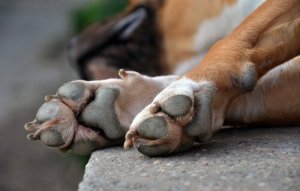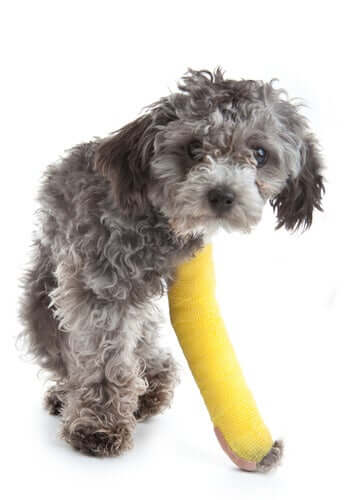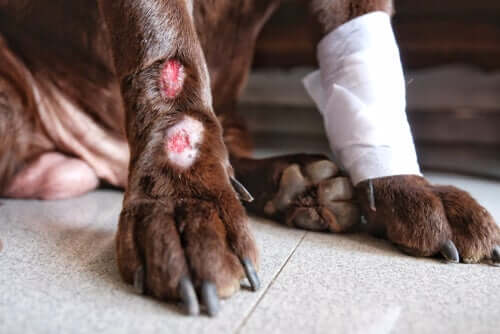How to Treat Injuries on Your Dog's Paws

Your dog’s paws are highly sensitive areas. Especially because dogs are active animals. They, like humans, can get all sorts of injuries such as broken bones, and torn muscles and ligaments.
These injuries can lead to sudden disability due to an inability to move. Pay special attention to things such as fractures, dislocations, and any bleeding that doesn’t stop within a minute or two. In this article, we’ll address the most common paw injuries that could afflict your dog.
1. Soft tissue injuries on your dog’s paws

Tendons, muscles, and ligaments are all types of soft tissues and many are located within the legs. Strains and sprains are common injuries in these.
These kinds of lesions can happen suddenly, especially when a dog slips on snow or ice. Also, when stepping onto unleveled terrain as they run. In addition, movements such as sudden turns, halts, and jumps could strain a muscle, a tendon or a ligament.
Not only that, simple actions such as jumping off the couch or bed often lead to injury. Many of us think that dogs are athletic and can withstand such sudden moves. However, accidents happen in the blink of an eye. There’s even a possibility of injury whenever your dog runs around the yard, or when they chase a ball or another dog.
Limping, the most common sign
If your pet is limping then take it as a sure sign that something is wrong with them. It could be as little a thing as a stone trapped in their pads. But it could be a soft tissue injury as well.
If you already checked their legs and found no cuts or anything else that could be the source of the limp, then take them to a vet so they can do an internal checkup. Many sprains are minor and will heal by limiting the animal’s activity. However, some are more serious and require medical attention as soon as possible.
There are many possible reasons for limping such as injuries, infections, inflammation, anatomical defects, cancer, and degenerative diseases. The onset of such lameness may be sudden (this is known as acute onset) or develop more slowly, due to a chronic condition.
2. Dog’s paws: lacerations, abrasions, and other wounds

A laceration is a skin cut and a scratch is a form of abrasion. Lacerations happen by exposure to sharp objects such as broken glass, irregular metal edges, a dog’s toenails or anything else that can penetrate the skin tissue.
Lacerations may either have a clean and tidy edge or be jagged and irregular. It all depends on what caused the injury. Abrasions occur when sliding or being pulled over a rough surface such as cement, rocks, and sand. Bite wounds are, obviously, caused by other animals.
3. Swollen dog’s paws

Swollen paws are a common problem among dogs. And even though this condition isn’t usually dangerous, it’s definitely uncomfortable and very painful as the legs are highly sensitive.
Swollen legs are often caused by a foreign object trapped between the pads. They may also be due to bloodsucker bites, puncture wounds, broken phalanges (fingers) or fractured claws.
The common canine habit of licking or chewing their own paws is another fairly common cause. Pad burns from running on hot asphalt are also common during the summer.
4. Cruciate ligament rupture
The technical term for this injury is cranial cruciate ligament rupture. A torn knee ligament destabilizes a joint.
The cruciate ligament connects the back of the femur with the front of the tibia. (The femur is the bone above the knee and the tibia is the one below the knee.) Thus, the ligament stabilizes the joint and keeps the tibia in place.
If your dog is limping on their hind leg, it may be because this ligament is broken or torn. Some breeds of dogs are at greater risk than others when it comes to this type of injury.
Labrador Retrievers, Newfoundlands, Mastiffs, Akitas, Staffordshire Terriers, Saint Bernards, Poodles, German Shepherds, Golden Retrievers, Chesapeake Bay Retrievers, Rottweilers, and Bichon Frises are all among the most commonly affected breeds when it comes to this kind of injury.
What factors are associated with rupture of the cruciate ligament in dogs?
Race, age, activity level, and obesity are all factors that influence a torn knee ligament. You can control your dog’s weight via regular exercise and a proper diet. Thus, prevention depends on you.
In severe cases of trauma, the limbs may hang at an unnatural angle when they fracture or dislocate, and the bones can even pierce the skin. Pets that drag a limb could also have nerve damage.
Care for a limping dog

Don’t move the dog; you must immobilize them if necessary. Try to confine and restrict your limping dog’s activity for a few days.
Check for broken bones (including dislocations) by observing the angle of the limb and its stability. As a general rule, if the limping can support weight then it isn’t likely to be a fracture.
If limping lasts for more than 24 hours, it could be due to a fracture. If there’s also severe swelling, or an inability to stand up, then the dog will require immediate veterinary attention.
Don’t administer over-the-counter medications without the guidance of a veterinarian. Ibuprofen, Tylenol, and aspirin can all lead to significant side effects and require a period of washing out before a vet can administer other analgesics.
Finally, never try to force a limping dog to walk or exercise. In fact, you should allow them to rest fully for at least a few days and up to several weeks.
When the limp disappears, you should let them rest for at least another 24 to 48 hours. Only afterward should you reintroduce activity and you must do so smoothly and progressively.
Your dog’s paws are highly sensitive areas. Especially because dogs are active animals. They, like humans, can get all sorts of injuries such as broken bones, and torn muscles and ligaments.
These injuries can lead to sudden disability due to an inability to move. Pay special attention to things such as fractures, dislocations, and any bleeding that doesn’t stop within a minute or two. In this article, we’ll address the most common paw injuries that could afflict your dog.
1. Soft tissue injuries on your dog’s paws

Tendons, muscles, and ligaments are all types of soft tissues and many are located within the legs. Strains and sprains are common injuries in these.
These kinds of lesions can happen suddenly, especially when a dog slips on snow or ice. Also, when stepping onto unleveled terrain as they run. In addition, movements such as sudden turns, halts, and jumps could strain a muscle, a tendon or a ligament.
Not only that, simple actions such as jumping off the couch or bed often lead to injury. Many of us think that dogs are athletic and can withstand such sudden moves. However, accidents happen in the blink of an eye. There’s even a possibility of injury whenever your dog runs around the yard, or when they chase a ball or another dog.
Limping, the most common sign
If your pet is limping then take it as a sure sign that something is wrong with them. It could be as little a thing as a stone trapped in their pads. But it could be a soft tissue injury as well.
If you already checked their legs and found no cuts or anything else that could be the source of the limp, then take them to a vet so they can do an internal checkup. Many sprains are minor and will heal by limiting the animal’s activity. However, some are more serious and require medical attention as soon as possible.
There are many possible reasons for limping such as injuries, infections, inflammation, anatomical defects, cancer, and degenerative diseases. The onset of such lameness may be sudden (this is known as acute onset) or develop more slowly, due to a chronic condition.
2. Dog’s paws: lacerations, abrasions, and other wounds

A laceration is a skin cut and a scratch is a form of abrasion. Lacerations happen by exposure to sharp objects such as broken glass, irregular metal edges, a dog’s toenails or anything else that can penetrate the skin tissue.
Lacerations may either have a clean and tidy edge or be jagged and irregular. It all depends on what caused the injury. Abrasions occur when sliding or being pulled over a rough surface such as cement, rocks, and sand. Bite wounds are, obviously, caused by other animals.
3. Swollen dog’s paws

Swollen paws are a common problem among dogs. And even though this condition isn’t usually dangerous, it’s definitely uncomfortable and very painful as the legs are highly sensitive.
Swollen legs are often caused by a foreign object trapped between the pads. They may also be due to bloodsucker bites, puncture wounds, broken phalanges (fingers) or fractured claws.
The common canine habit of licking or chewing their own paws is another fairly common cause. Pad burns from running on hot asphalt are also common during the summer.
4. Cruciate ligament rupture
The technical term for this injury is cranial cruciate ligament rupture. A torn knee ligament destabilizes a joint.
The cruciate ligament connects the back of the femur with the front of the tibia. (The femur is the bone above the knee and the tibia is the one below the knee.) Thus, the ligament stabilizes the joint and keeps the tibia in place.
If your dog is limping on their hind leg, it may be because this ligament is broken or torn. Some breeds of dogs are at greater risk than others when it comes to this type of injury.
Labrador Retrievers, Newfoundlands, Mastiffs, Akitas, Staffordshire Terriers, Saint Bernards, Poodles, German Shepherds, Golden Retrievers, Chesapeake Bay Retrievers, Rottweilers, and Bichon Frises are all among the most commonly affected breeds when it comes to this kind of injury.
What factors are associated with rupture of the cruciate ligament in dogs?
Race, age, activity level, and obesity are all factors that influence a torn knee ligament. You can control your dog’s weight via regular exercise and a proper diet. Thus, prevention depends on you.
In severe cases of trauma, the limbs may hang at an unnatural angle when they fracture or dislocate, and the bones can even pierce the skin. Pets that drag a limb could also have nerve damage.
Care for a limping dog

Don’t move the dog; you must immobilize them if necessary. Try to confine and restrict your limping dog’s activity for a few days.
Check for broken bones (including dislocations) by observing the angle of the limb and its stability. As a general rule, if the limping can support weight then it isn’t likely to be a fracture.
If limping lasts for more than 24 hours, it could be due to a fracture. If there’s also severe swelling, or an inability to stand up, then the dog will require immediate veterinary attention.
Don’t administer over-the-counter medications without the guidance of a veterinarian. Ibuprofen, Tylenol, and aspirin can all lead to significant side effects and require a period of washing out before a vet can administer other analgesics.
Finally, never try to force a limping dog to walk or exercise. In fact, you should allow them to rest fully for at least a few days and up to several weeks.
When the limp disappears, you should let them rest for at least another 24 to 48 hours. Only afterward should you reintroduce activity and you must do so smoothly and progressively.
All cited sources were thoroughly reviewed by our team to ensure their quality, reliability, currency, and validity. The bibliography of this article was considered reliable and of academic or scientific accuracy.
- Renkin, E. M., Carter, R. D., & Joyner, W. L. (1974). Mechanism of the sustained action of histamine and bradykinin on transport of large molecules across capillary walls in the dog paw. Microvascular research, 7(1), 49-60.
- Joyner, W. L., Carter, R. D., Raizes, G. S., & Renkin, E. M. (1974). Influence of histamine and some other substances on blood-lymph transport of plasma protein and dextran in the dog paw. Microvascular research, 7(1), 19-30.
- Adelman, S., Taylor, C. R., & Heglund, N. C. (1975). Sweating on paws and palms: what is its function?. American Journal of Physiology-Legacy Content, 229(5), 1400-1402.
This text is provided for informational purposes only and does not replace consultation with a professional. If in doubt, consult your specialist.








